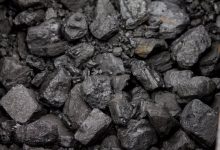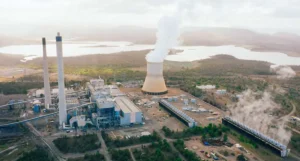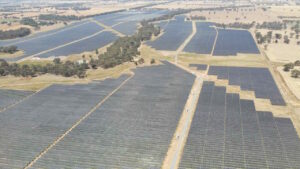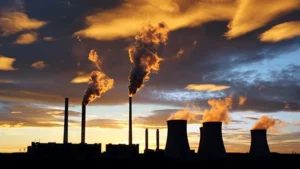Wood Mackenzie, a consultancy which is used by the International Energy Agency (IEA) and major coal companies, estimates seaborne thermal coal use would have to fall by 40 per cent by 2035 to meet the target of limiting global warming to a two-degree increase.
While Wood Mackenzie issued a media release touting the findings of its 10-page report, which sells for US$4560, it declined to respond to inquiries about its findings or provide a copy of the report.
In its media release WoodMac – as the consultancy is commonly referred to – estimated that by 2035 coal would plummet to just a 16 per cent share of power generation from 41 per cent in 2013 if the IEA’s 450 Scenario was achieved.
In its annual modelling the IEA produces three scenarios: the Current Policies scenario, the New Policies scenario and the 450 scenario. Coal lobby groups prefer to approvingly cite the New Policies scenario – which projects rapidly growing coal demand equating to about a 3.6 degrees temperature increase – and ignores the 450 scenario which nominally equates to a two-degrees scenario.
A dramatic decline in coal power generation, WoodMac estimated, could see the global thermal coal trade drop from an estimated 900 million tonnes in 2016 to 527 million tonnes by 2035.
The IEA’s 450 Scenario assumes Carbon Capture and Storage (CCS) is viable after 2020, is rapidly deployed to three-quarters of the coal fleet by 2040 and preserves a high level of coal use. However, with CCS projects faltering and proving far more costly than renewables, achieving the IEA’s 450 scenario without the widespread deployment of the technology would require even greater cuts to thermal coal consumption.
WoodMac declined to comment on what its assessment is of the viability of CCS after 2020.
Nor did WoodMac respond to whether its report addressed the question of what the implications of keeping the temperature increase to “well below 2°C” – as the Paris Agreement states – would mean for the global coal trade.
Going down
Even so, WoodMac estimates concerted global action to reach the 2 degrees target would cause major production cuts in the world’s big coal exporters.
Indonesia, as the largest thermal coal exporter, would be hit hard, with WoodMac estimating exports could fall from an estimated 340 million tonnes in 2016 to 193 million tonnes by 2035.
Australian exports could fall from an estimated 210 million tonnes in 2016 to 135 million tonnes by 2035. Currently, the overwhelming bulk of Australian thermal coal exports originate from the Hunter Valley in New South Wales, underlining the shift likely to hit this region hard in the decade or so ahead.
While WoodMac’s media release stated combined exports from Colombia, Russia and South Africa – the other leading thermal coal exporters – would be “less than Australia in 2035”, the consultancy declined to provide a more detailed country-by country breakdown.
Amongst importers, WoodMac estimates imports to Europe and North and South America could fall by more than half to 80 million tonnes and 15 million tonnes respectively.
Asian imports could decline from an estimated 673 million tonnes in 2016 to 433 million tonnes, the consultancy stated. Aside from noting “a bearish coal import outlook for Japan, South Korea, Taiwan and Southeast Asia”, WoodMac declined to provide a more detailed breakdown.
Major coal power plans in countries such as India, Myanmar and the Philippines are in a state of flux, with major cuts to the number of proposed coal plants likely. Vietnam, another key potential source of coal demand, has trimmed the number of proposed coal plants back a little but has not yet signalled a major retreat despite the rapid decline in the cost of renewables.
In comments to WorldCoal, the World Coal Association’s website, WoodMac’s Research Director for Global Coal Markets, Jonny Sultoon, explained if Japan – a major customer for Australian exports – met its current 2030 goal of coal accounting for 25 per cent share of fuel mix, coal imports would fall to 100 million tonnes.
In 2015 Japan imported 114 million tonnes of thermal coal, of which over two-thirds came from Australia.
However, Sultoon stated that even if all of the Nationally Determined Contributions submitted in support of the Paris Agreement were implemented that would at best cap the temperature increase at between 2.7°C and 3.3°C.
Achieving a 2°C target would require Japan to cut imports to between 50 to 60 million tonnes a year.
WoodMac estimates the price of global thermal coal would fall significantly to below US$50 per tonne long-term.
WoodMac and the coal lobby
Wood Mackenzie has long been the coal industry’s market consultant of choice and was, at least until earlier this year, a member of the US mining industry’s peak lobby group, the National Mining Association (NMA). The company did not respond to questions on whether it is still a member and, if not, when it resigned and why.
Wood Mackenzie’s estimates of coal industry trends have long been contentious for overestimating demand. In June 2013 it claimed China’s coal consumption would double by 2030 and US coal producers would be exporting hundreds of millions of tonnes to the Asian market by then too. Both estimates have proven to be fanciful, which the consultancy has gradually backtracked from.
On September 8 – two days after the media release was issued – WoodMac Tweeted that its assessment of the IEA’s 450 Scenario “is not WoodMac’s base case view of thermal coal trade.” WoodMac declined to comment on whether this was prompted by concern from coal industry clients over the original media release.
Nor did WoodMac indicate what its current base case for thermal coal is in 2035 and why it downplays the likelihood of the IEA’s 450 Scenario coming to fruition.
Bob Burton is the Editor of CoalWire, a weekly bulletin on global coal industry developments. (You can sign up for it here.) His Twitter feed is here.











